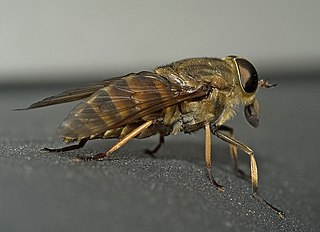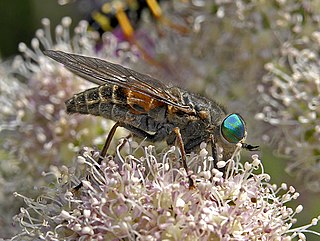
Tabanus is a genus of biting horseflies of the family Tabanidae. Females have scissor-like mouthparts that aim to cut the skin. The horsefly can then lap up the blood. Horseflies of this genus are known to be potential vectors of anthrax, worms and trypanosomes. Some species, such as Tabanus bovinus, prefer bovine animals and are less harmful to humans. The genus contains hundreds of species and many species groups.

Tabanus autumnalis, the large marsh horsefly, is a medium-sized species of biting horse-fly. It is somewhat scarce compared to T. bromius and T. bovinus. This species shows slightly more of a preference for coastal marsh than some of the other European Tabanus, sometime even found in saltmashes. Wing length is 13–16 mm and about 16–22 mm in body length.

Tabanus maculicornis also known as the narrow-winged horsefly is a species of biting horse-fly.
Tabanus miki also known as the plain-eyed brown horsefly is a species of biting horse-fly.

Tabanus sudeticus, also known as the dark giant horsefly, is a species of biting horse-fly. It is the heaviest fly in Europe.
Tabanus spodopterus also known as the black horned giant horsefly is a species of biting horse-fly. It is widespread in Europe, but only one doubtful specimen has been found in the United Kingdom.

Tabanus eggeri is a Mediterranean species of biting horse-fly, found in southern France, Italy, Albania, Croatia, Herzegovina, Bulgaria, Portugal and Morocco. There are also unverified accounts of sightings in Spain and Israel.

Atylotus rusticus is a species of horse-flies in the genus Atylotus. It is found in Europe, Asia and North Africa.

Chrysops caecutiens, common name splayed deer fly, is a species of horse fly belonging to the family Tabanidae. It is also known by the colloquial name Scotch Cleg.
Haematopota grandis is a species of Horse-fly. Its common name is the long-horned cleg. It is native to Europe, where it is distributed in Albania, Austria, Bulgaria, Czech Republic, Denmark, France, Germany, Greece, Hungary, Italy, Moldova, Romania, Slovakia, Spain, Sweden, Switzerland, Ukraine, and all states of former Yugoslavia.
Haematopota subcylindrica is a species of horse-flies that can be found in such European countries as Austria, Belgium, Great Britain including the Isle of Man, Bulgaria, Czech Republic, Denmark, France, Germany, Hungary, Italy, Liechtenstein, Lithuania, Poland, Romania, Russia, Slovakia, Sweden, the Netherlands, and in all states of former Yugoslavia. It can also be found in Near East including Middle East.

Hybomitra montana, the slender-horned horsefly, is a species of horse flies in the family Tabanidae.

Hybomitra muehlfeldi is a species of horse flies belonging to the family Tabanidae. It is a Palearctic species with a limited distribution in Europe.
Hybomitra lurida is a species of horse-fly in the family Tabanidae. It is found across central and Northern Europe and Asia. It is a large fly, between 12–15 millimetres long.
Atylotus latistriatus is a Palearctic species of horse fly in the family Tabanidae.
Atylotus plebeius is a Palearctic species of horse fly in the family Tabanidae.

Hybomitra bimaculata is a Palearctic species of horse fly in the family Tabanidae.

Hybomitra distinguenda is a Palearctic species of horse fly in the family Tabanidae.
Hybomitra expollicata, also known as the striped horsefly, is a Palearctic species of horse fly in the family Tabanidae.
Hybomitra solstitialis is a Palearctic species of horse fly in the family Tabanidae. Continental authorities apply the name solstitialis to the coastal species Hybomitra ciureai of British authorities and regard British solstitialis as var. collini of Hybomitra bimaculata.












